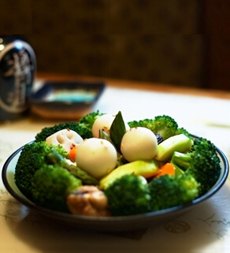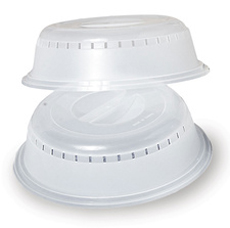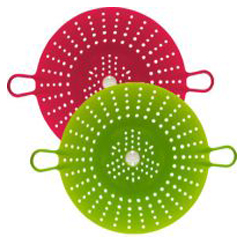
Delicious, healthy, low in calories. Photo of steamed vegetables courtesy Tenzan Restaurants.
|
KAREN HOCHMAN is Editorial Director of THE NIBBLE. |
|
March 2011 |
 |
Steaming Vegetables
How To Steam Vegetables In The Microwave And On The Stovetop
Steaming Vegetables Overview
Most of us don’t eat our recommended daily portions of fruit and vegetables (use this calculator to see how much you need).
You can serve a side of vegetables with breakfast eggs, with lunch and of course, with dinner. At the end of the day, if we haven’t eaten our share, we steam vegetables as a snack.
We steam them in the microwave, which couldn’t be easier. All you need are vegetables, a microwave-safe container (or a bowl and plastic wrap), and the veggies.
Steaming retains more nutrients than other cooking methods, and maximizes the flavor and color of the vegetables. You can steam your vegetables to the crunchy/al dente state or any other consistency. But take care not to overcook: Better al dente than mushy.
Steaming Vegetables In The Microwave
- Place vegetables in a microwave-safe bowl (we use our tortilla steamer), add a small amount of water—a half inch to an inch or more, depending on the size of the bowl. For more flavor, you can add some balsamic, sherry or wine vinegar to the water.
 Cover the bowl with a microwave-safe vented lid or with microwave-safe plastic wrap. Cut a small slit in the plastic wrap to vent. Cover the bowl with a microwave-safe vented lid or with microwave-safe plastic wrap. Cut a small slit in the plastic wrap to vent.
Photo courtesy Current Catalog.
- It’s even easier to use special microwave steaming bags from Glad (Simply Cooking) and Ziploc. However, it’s better for the environment to use a microwaveable bowl and lid.
- Fresh vegetables have so much flavor, we eat them plain. If you need seasoning beyond salt and pepper, try a squeeze of lemon or lime juice (we love bottled yuzu juice, fresh herbs, a drizzle of olive oil or soy sauce).
What about cooking times? Here’s a chart for both microwave and conventional steaming.
If you’re cooking a medley of vegetables with different cooking times, start by cooking the vegetables that require the most time. Then count down and add the lighter vegetables.
After you get the hang of it, try steaming fish!
Steaming Vegetables On The Stovetop
All you need are a pot with a lid and a collapsible steamer basket (there are 9" and 11" versions, depending on how much you steam at once). We graduated to a silicone steamer after a steam of poorly-made metal steamers fell apart.
- Fill the pot with enough water to reach the bottom of the steamer.
- Bring water to a boil and add vegetables. The lid should be loose fitting so steam can vent; otherwise, position it so that there is some room for steam to escape.
- Steam according to chart directions.
|
|

Our steamer of choice: the Chef ‘n Sleekstor VeggiSteam Silicone Steamer. |
What about those electronic vegetable steamers? They work, but they take up space and are more cumbersome to use and clean than the microwave and stovetop methods.

|





 Cover the bowl with a microwave-safe
Cover the bowl with a microwave-safe